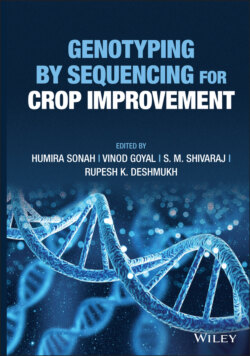Читать книгу Genotyping by Sequencing for Crop Improvement - Группа авторов - Страница 49
2.2.2.1.3 Hybridization‐based Platforms or Array‐based Methods
ОглавлениеHybridization methods exploit differences in dsDNA thermal stability to discriminate between perfectly matched and mismatched target‐probe combinations in order to achieve allelic discrimination. In the array‐based system, customized probes from the flanking sequence of the SNP are used for genotyping. For a particular locus, the number of probes to be used depends on the number of alleles present. SNPs are usually biallelic in nature, hence mostly two probes distinguishing both alleles are used for each locus. The probes in the SNP array are hybridized with DNA samples to determine the specific alleles of all SNPs on the array for the hybridized DNA sample (LaFramboise 2009). This kind of array has been successfully used in several crops like rice (Thomson et al. 2017; McCouch et al. 2017) maize (Unterseer et al. 2014), wheat (Wang et al. 2014), and barley (Bayer et al. 2017). The number of SNP genotyped at one go has been scaled up to 700 k in rice (Mccouch et al. 2016) and 820 k in case of wheat (Winfield et al. 2016).
There are several well‐established genotyping platforms which can be used for customizing a new array, two of which, i.e., Illumina Infinium Beadchip and Affymetrix GeneChip are most widely used. Further, a new concept of customized array which has a highly specific set of probes used to validate known SNPs in subsets of population is emerging nowadays. Both of the above mention genotyping technology are briefly described below
1 Illumina’s Infinium Beadchips: Infinium array was capable of genotyping only 10k–100k SNPs initially which later has been increased up to 1000k SNPs. It includes first a whole‐genome amplification step, followed by hybridization to bead arrays of 50 bp long capture probes. The locus‐specific sequences include an allele‐specific 3′ terminal base. An allele‐specific primer extension reaction is used to incorporate biotin‐labeled nucleotide‐based or single‐base primer extension step detection systems for positive detection.
2 Affymetrix GeneChip: The GeneChip assays are based on allelic discrimination by direct hybridization of genomic DNA to allele‐specific oligonucleotides (25 mers probes). These oligonucleotides represent all allelic combinations for the particular loci, i.e. perfect match or mismatch probes to each SNP. The range of SNPs to be genotyped ranges from 10k to 2000k SNPs. As gene chip requires high‐quality DNA, so for GeneChip assays to work efficiently, the complexity of the genomic DNA must be reduced through digestion with restriction endonucleases and fractionation. In previous years, researchers used a high‐density oligonucleotide probes array to genotype the entire genome, paving the way for genome‐wide association studies (GWAS) (Kennedy et al. 2003; Matsuzaki et al. 2004; McGall and Christians 2002). Affymetrix GeneChip array contains a large number of synthetic fragments (25‐mer) probes immobilized on a solid substrate. First, the denatured ssDNA are hybridized with these probes, which takes place in a highly specific manner as noncomplementary alleles will not hybridize. Subsequently, the fragments of noncomplementary strands are washed away. The hybrid strands containing probes are stained and then the gene chip is subjected to the CCD imaging device for scanning. Each SNP is represented by a probe set that contains multiple probe pairs. The probe pairs differ in the location of SNP within the oligonucleotide sequence (5 location’s probes are selected). For each position, probes are included from the sense and antisense strand. Hence, the total probes for each allele are 40 probes per SNP.
Although DNA array‐based genotyping has completely revolutionized the field of RNA sequencing and expression analysis, but comparably it has lesser use for SNP genotyping mainly because of the difficulty in obtaining a good signal/noise ratio in allele‐specific hybridization. The resolution of discrimination between completely matched/mismatched oligonucleotides in the array is totally based on high‐throughput fluorescence detection system which is further complicated with an increase in the number of SNPs to be genotyped under a single condition. This specificity compromises genotype call rates and accuracy. Generally, effectiveness in allele differentiation depends on length and sequence of the probe, location of SNP in the probe, and hybridization conditions (Table 2.1).
Table 2.1 Customized SNP array details in plant species.
| Crop | Species | Array fsize | References | Trait |
|---|---|---|---|---|
| Pigeonpea | (Cajanus cajan) | 62K | Singh et al. (2020) | Genetic diversity |
| Wheat | (Triticum) | 55K | Zhang et al. (2019) | Adult‐plant resistance to leaf and stripe rust |
| Apple | (Malus domestica) | 480K | Bianco et al. (2016) | Phenology, fruit quality, disease resistance, or drought tolerance |
| Apple | (Malus domestica) | 8K | Chagné et al. (2012) | Quantitative traits |
| Rice | (Oryza sativa) | 50K | Singh et al. (2015) | Genetic diversity |
| Rice | (Oryza sativa) | 44 K | Zhao et al. (2011) | Plant morphology, grain quality, plant development |
| Rye | (Secale cereale) | 5 K | Li et al. (2011) | Diversity analysis |
| Barley | (Hordeum vulgare) | 50 K | Bayer et al. (2017) | Evaluation and use of barley genetic resources |
| Sweet Cherry | (Prunus avium) | 6K | Peace et al. (2012) | Fruit taste |
| Pear | (Prunus) | 70K | Montanari et al. (2019) | Genetic diversity studies |
| Potato | (Solanum tuberosum) | 22K | Khlestkin et al. (2019) | Starch phosphorylation |
| Pear | (Pyrus) | 200K | Li et al. (2019) | Flowering time and candidate genes linked to the size of fruit |
| Walnut | (Juglans regia) | 700K | Marrano et al. (2019) | Genetic diversity of germplasm |
| Cotton | (Gossypium barbadense) | 63K | Kumar et al. (2019) | Fiber quality |
